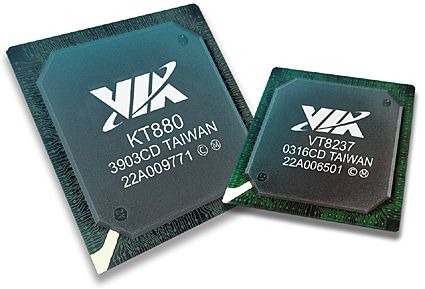VIA KT880 Chipset Analysis
Tarinder is right, the easiest way to get a handle on a new chipset is to look at its block diagram first.
DualStream64TM
As you all know, the fastest Athlon XPs currently available are 200MHz bus versions. The CPU bus is 64-bits wide (8 bytes) and DDR, so that's 200 x 2 x 8 for a grand total of 3200MB/sec of available CPU-to-bridge bandwidth. Since that's the bus bandwidth limit, that's all the CPU is ever going to be able to pull from the memory controller.Therefore dual-channel 64-bit memory controllers for Athlon XP, like the DualStream64 controller in KT880, are a bit of indulgent excess, rather than a necessity. Two memory controller means twice the bandwidth that the CPU can make use of, leaving a large excess of bandwidth, hopefully usable by other things. VIA's product literature for KT880 makes no explicit reference to the excess bandwidth being usable by other devices in the system, much like NVIDIA's MCP-T southbridge and data prefetcher can. Do we therefore assume that the excess really is excess, or do we assume that peripherally connected devices, by way of the V-Link bridge connection that the bridges have, can poke around on the memory controllers and use them at the same time as the CPU?
It's hard to say. If I had to make a guess, by virtue of the lack of explicit literature on the topic, that it's no more than a copy of the PT880 memory controller and therefore unusable by the southbridge or connected peripherals. Say hello to a pointless feature. We've already seen that single-channel KT600 can keep good pace with nForce2 Ultra 400, if only in reference board form, so it's clear that the extra memory bandwidth is barely being used in most situations with that bridge, even though the MCP-T is quite capable of doing so. So even if KT880 could be well utilised, it's arguable that it wouldn't make much difference anyway.
Pointless feature it may be, but it's important to marketing types who can now put a tick in that particular box.
V-Link
Ultra V-Link is VIA's name for the newly uprated bridge interconnect that it employs on its chipsets. 1066MB/sec of potential bandwidth means plenty for even 2 Gigabit Ethernet network devices, a pair of RAID0-capable SATA150 channels, a couple of discrete PCI busses and a decent audio solution. So it's some surprise to see VIA neglect to make KT880's bridge connection Ultra V-Link spec. It's just regular 533MB/sec V-Link in this case. While that's still enough for most circumstances, it would be nice to see it make an appearance with KT880.AGP 3.0 Support
Really? Who'd have thought it.
VT8237 Southbridge
Ah, here we go, something worth talking about. The VT8237 is possibly VIA's best bit of silicon, a feature rich bridge capable of augmenting almost everything you'd possibly want onto a motherboard without using a single PCI slot. And if you do find it lacking, it supplies the PCI slots your heart desires too. Hurrah.DriveStation is VIA's marketing hyperbole for their disk controller. It implements a pair of SATA channels with which you can apply RAID0, RAID1, RAID0+1 (if your board maker augments a compatible PHY to the 'hanging' DriveStation secondary PATA channel, giving you four SATA channels in total) and JBOD (just a bunch of disks).
Bear in mind that adding that PHY means the secondary PATA channel disappears, leaving you with a single primary PATA channel for up to two optical or regular IDE disks. As Tarinder says, you can have 4 SATA, 2 PATA or 2 SATA, 4 PATA with DriveStation. DriveThru software helps you setup your RAID array from Windows, without using the controller BIOS on system startup, making things a little easier.
Vinyl Audio is the audio solution that the VT8237 can power. Hopefully most board makers will add one of VIA's Envy ASICs, for eight-channel support, although there's still the Six-Trac ASICs for a more regular, limited, six-channel approach. The audio flexibility allowed with the VT8237 and the Envy series of chips means that VT8327-driven motherboards are capable of the best on-board audio solution that money can buy. Here's hoping that manufacturers give you the goodness, the reference board takes advantage, as you'll soon see.
As far as high speed serial connectivity goes, we have eight possible USB2.0 ports and VIA's FireWire ASICs are all available for use. While a native FireWire solution would be nice, aiding its acceptance on more motherboards, it's acceptable that VIA at least provide low cost methods for adopting it, should board makers wish to. It's still considered somewhat of a high end feature, for reasons I can't quite understand, but at least there's the option.
Everything else is as standard as standards get, at least on current PCs. PCI busses, LPC I/O, an Ethernet interface and PS/2 HID controller. The Ethernet interface is worth a mention, since a strong option for KT880 is the Velocity chip that debuted with PT880. It's a Gigabit Ethernet controller that rides the PCI bus (the VPX2 PCI-X segment bridge available with PT880 doesn't seem to be an option with KT880) and gives the chipset base support for a VIA-supported GigE connection.









